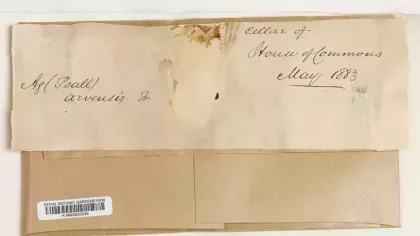Digitising Kew’s plant pathogen collection
Providing the evidence to study and combat the fungi of most threat to plant health in the UK.

An estimated 1.25 million specimens of dried fungi are housed in the Fungarium at Kew. However, the wealth of information held within the collection cupboards is largely unavailable to researchers worldwide. By providing images and data from these specimens online, anyone will be able access the specimen information they need.
Fungal diseases of UK plant species have recently been given high public profile due to their great potential impact on the UK natural and cultivated flora and on the landscape of the British Isles. These fungal diseases include ash die-back (Hymenoscyphus fraxineus); sweet chestnut blight (Cryphonectria parasitica) and blight diseases caused by various species of Phytophthora. There are 132 fungal diseases on the UK Plant Health Risk Register. This list helps prioritise action against pests and diseases which threaten our crops, trees, gardens and countryside. Unfortunately little is known about the natural distribution of these fungal pathogens, and the genetic diversity of the pathogens and their hosts is poorly understood. Data on the variation and diversity of both fungus and host is critical if we are to combat the spread of plant fungal pathogens. Currently for many pathogens we do not understand which strains occur where, in which areas they cause disease and which populations of hosts are seemingly resistant to the pathogen.
Kew’s Fungarium holds specimens from throughout the UK and adjacent areas of Europe. It provides a unique resource to guide researchers seeking to understand the distribution and variation of these pathogens. It contains specimens from every part of the globe, and reflects the importance of fungi pathogens, in addition to their role as providers of food, medicines, enzymes and essential ecosystem services. However, the wealth of information held in the Fungarium collection, including data on the distribution of the fungi and their host relationships, is still held within our collection cupboards and largely unavailable to researchers worldwide. Through this project we will digitise UK fungi on the Risk Register, and genera known to be broadly pathogenic, such as rusts and smuts and therefore those fungi posing the greatest risk to the UK natural and cultivated flora. Digitisation will provide data from these collections openly through the internet, informing researchers of the collections that Kew holds, and promoting access to the collections for genetic and other research. It is estimated that we will capture images from around 10,000 collection labels and representative collections of the fungi plus host. We will capture baseline data through transcription of the images, and explore crowdsourcing as a methodology for full data capture. The data will be made available via Kew’s website and global portals such as the Global Biodiversity Informatics Facility.
Objectives:
- To significantly increase access to the Fungarium collection - specifically plant pathogenic fungi.
- To provide a source of data which will facilitate research into plant pathogenic fungi
- To increase awareness of the fungal collection at Kew by inviting the public to transcribe specimens via a crowdsourcing transcription website.
- Images of collection labels captured for 10,000 fungal specimens and baseline data transcribed from these images.
- Full data captured from a subset of these images via crowdsourcing.
- Data made available through Kew’s website and the Global Biodiversity Information facility (GBIF.org)
HDH Wills 1965 Charitable Trust
